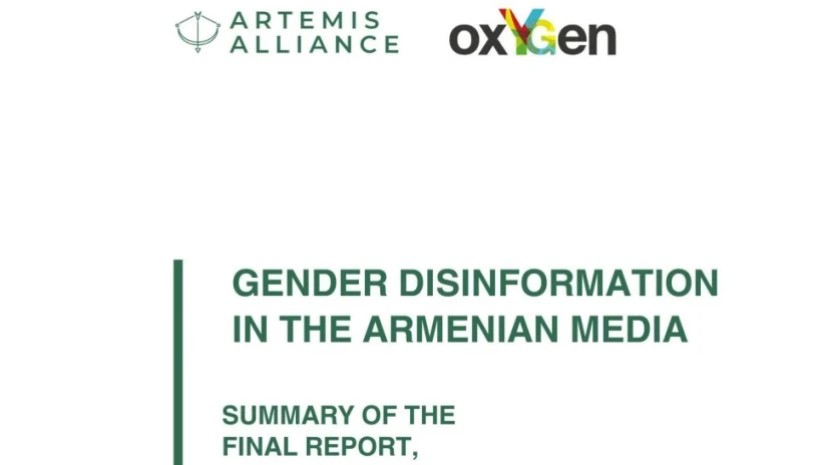In Armenia, women politicians, experts, and public figures are often subjected to various false and manipulative publications in Armenian media—not because of their activities, but because of their gender. A six-month monitoring effort identified 332 such cases.
"I did not interrupt you... out of respect for your gender, among other reasons... You tell me that I am fulfilling an order, you don’t have to be polite, but I do? I will continue as well, don’t interrupt me..." — this was the statement of Armenian Foreign Minister Ararat Mirzoyan directed at opposition MP Anna Grigoryan in the National Assembly of Armenia. This is not an isolated case of gender-based attacks against women politicians in Armenia. Such statements are often amplified in the press, creating a fertile ground for the spread of gendered disinformation.
Gendered disinformation is a specific type of "information" that involves the deliberate creation and dissemination of false, misleading, or manipulative narratives related to a person’s gender.
332 Cases in Six Months
Monitoring conducted by the OxYGen Foundation for the Protection of Youth and Women’s Rights from February to July 2024 covered 12 Armenian media outlets. Researchers classified them into three groups: those that most frequently criticize the authorities, those that most frequently attack opposition women politicians, and relatively neutral outlets.
The study found that out of 92,568 publications, 332 contained gendered disinformation, with 202 of them having a political focus. Notably, 331 out of these 332 cases were registered in online media, with only one appearing on television.
The research identified several examples of gendered disinformation. "We need to go into Anna’s and Zhanna’s offices—escort them in handcuffs to Abovyan penitentiary," and "A lady specializing in curses and anathemas..." are just a few of the headlines used against women politicians.
The victim-blaming approach is also widespread. A striking example of "victim-blaming" discourse was the media coverage of violence against a 13-year-old girl, in which outlets wrote that "the girl did not have particularly good behavior." This demonstrates how gendered disinformation, whether intentional or not, is used to shift blame onto the victim and downplay the severity of crimes.
An example of spreading gender stereotypes includes the words of a psychologist who asserted that a woman’s role is to "create, nurture, and preserve the home," that her primary place is in the family, and her main mission is to establish peace within it. "This limits women’s place and role, their involvement, and participation in various spheres of public life," note the authors of the study.
In the context of "national security," women are often labeled as "corrupt" and "unpatriotic."
In these cases, according to the study’s authors, gendered disinformation is primarily used to influence political sentiments or processes and to silence women politicians.
What Can Businesses Do?
The study, as noted by OxYGen Foundation’s Communications Coordinator Narine Yeganyan, identified the main narratives behind the spread of gendered disinformation in the information space.
According to the monitoring results, online media are the primary source of gender stereotypes and disinformation. Many of these outlets exhibit overlapping discourses, where gendered disinformation intertwines with other themes. For example, legislative initiatives proposed by women MPs are often framed as part of a "Soros agenda."
Notably, in the preliminary stage of the monitoring, four out of the 16 analyzed media outlets did not exhibit any disinformation flow. This may be due to stricter editorial policies, the study’s authors suggest.
Based on the monitoring results, journalists are responsible for spreading gendered disinformation in most cases—155 instances in total. Of these, 54 were authored by male journalists, 34 by female journalists, and in 67 cases, the author’s gender was unknown due to anonymity. Politicians ranked second with 115 cases (59 women, 56 men), followed by experts with 22 cases (16 men, 6 women).
It was found that journalists often spread such disinformation unintentionally, simply by quoting opinions expressed by politicians or public figures.
"This issue requires broader coverage, where the role of both the media and their funding structures is crucial," notes OxYGen Foundation’s Communications Coordinator Narine Yeganyan.
The study also highlights the vital role of the private sector in addressing this problem. According to Yeganyan, businesses often limit their efforts to ensuring gender balance in the workplace, whereas gendered disinformation is also a component of inequality.
Proposed Solutions
As a result of the study, several solutions have been proposed. These include incorporating provisions on gendered disinformation into the Law on Equal Rights for Women and Men, adopting an anti-discrimination bill, developing ethical guidelines for the media, and conducting training sessions for journalists.
Additionally, it is suggested to establish a unified support platform for women, involving experts and civil society representatives. This platform would respond quickly to such cases and organize preventive campaigns.
"Gendered disinformation has become a systemic issue that hinders not only the professional advancement of individual women but also the broader participation of women in socio-political life. It deepens gender inequality and reinforces harmful stereotypes," the study’s authors note.
The researchers call on organizations to review their internal procedures for working with the media and to implement clearer standards. "This will foster mutual learning and enhance gender sensitivity, ultimately benefiting society as a whole," concludes Yeganyan.
















